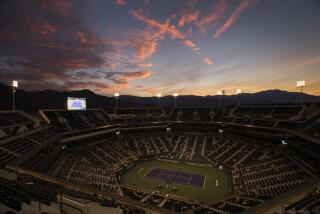An Aye for an Eye
- Share via
Robby Ginepri watched an opponent’s shot land out on match point -- at least he thought so -- and put his hands in the air, walking toward the net, believing his job was done.
Not quite. The ball was called good that day five years ago at Indianapolis. Ginepri ended up losing the set and had to go three against Karim Alami before winning the first-round match.
Ginepri was in Indianapolis last week playing another early-round match. It was 5-5 in the second set and his opponent, Alejandro Falla, was serving at 40-15 and hit a second serve. Ginepri guided a backhand return up the line and the shot was called out.
This time, Ginepri had recourse to support his suspicion. He challenged the call and the instant replay technology in use showed he was correct, that the ball was in. Had there been no instant replay, Falla would have been up, 6-5. Instead, Ginepri went on to break Falla’s serve in that game and won the match in three sets.
Victory, Ginepri. Assist, Hawk-Eye.
“No complaints over here,” Ginepri said in a telephone interview last week from Indianapolis. “I like it myself. I think it’s good for the game. It gives the fans something else to look forward to during the match, keeps them on the edge of their seats and it is easier for the players and the umpires because right or wrong, you’re going to get to the bottom line.”
The age of instant replay on the main stage of professional tennis had its debut at a Miami tournament in March, and will be unveiled for local tennis fans in the three upcoming Southern California hard-court events that are part of the 10-tournament U.S. Open Series. It starts today with a men’s tournament, the Countrywide Classic at UCLA, featuring Andy Roddick, Ginepri, Lleyton Hewitt and Andre Agassi, who will be making his final tour appearance in Los Angeles before retiring.
Following the UCLA event are two women’s tournaments on the Sony Ericsson WTA Tour, the Acura Classic at La Costa from July 31-Aug. 6 and the JPMorgan Chase Open in Carson from Aug. 7-13. Sisters Venus and Serena Williams and Maria Sharapova are scheduled to play in Carson.
Also entered in all three tournaments: The Hawk-Eye line-calling system, named after its inventor, Paul Hawkins.
It was Serena Williams who became an unwitting catalyst for instant replay. The issue of line calling came under scrutiny when she was victimized by a particularly egregious overrule in her quarterfinal match at the 2004 U.S. Open against Jennifer Capriati.
So perhaps it is fitting that the U.S. Open will be the first Grand Slam event to use Hawk-Eye.
As in Miami, players will have two challenges per set and another should the set reach a tiebreaker. If a player is correct with a challenge, as Ginepri was against Falla, it does not count against the player.
Players in Miami challenged calls 161 times and 53 were reversed. Reaction was largely positive for the trial run, though Hewitt noted an annoying trend in his brief experience in Miami.
“Occasionally there was a little bit of Mickey Mouse sometimes where players, especially toward the end of sets, just [used] the chance to challenge calls when they had a few up their sleeve,” he said. “So that’s probably my biggest question mark with the whole thing.”
Carson will have two large video boards in the stadium to show the computer-enhanced, comet-like path and landing of the ball on challenged calls. All this takes place in a matter of seconds. Ten cameras will be positioned around the court to track the shots.
Bill Peterson of AEG Sports, the tournament director of the Carson event, spoke about the enhancement for fans in the stadium.
“All of a sudden you have a very compelling component added to the game,” he said. “If you questioned a call in the past, it was really between you and whoever you were sitting beside.
“Now you’ve got this technology that pops up on the big screens and it adds a little tension to the entire event -- is a player going to challenge or not challenge it?”
Bob Kramer, tournament director at UCLA, said his event will have one video board and that the enhancement package for the board cost his event an additional $20,000. “I don’t see any downside to it,” he said.
In Carson, the USTA, WTA and ESPN will be picking up the cost of the Hawk-Eye system, and the tournament is paying for the two video boards, making the total expense about $100,000. At UCLA, the USTA, ATP and ESPN are paying for Hawk-Eye. La Costa has an existing agreement with ESPN, so the tournament is paying for 50% of Hawk-Eye, with the WTA and ESPN splitting the other 50%.
Acura tournament director Raquel Giscafre said the tournament won’t have a video board because the stadium had already been configured for this year’s event, including stadium seating, when the decision was made for the U.S. Open Series to go forward with instant replay.
“It was just too late in the game when everything was decided,” she said. “Next year we will most likely have it.... I think it’s a nice addition to the show.”
Giscafre was asked if she wished instant replay had been around in her days on the tour in the ‘70s.
“When I was playing professionally, I don’t think a microphone existed,” she said, laughing.
More to Read
Go beyond the scoreboard
Get the latest on L.A.'s teams in the daily Sports Report newsletter.
You may occasionally receive promotional content from the Los Angeles Times.











